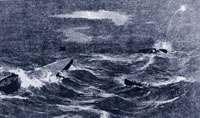| WOMEN IN TRANSPORTATION |
| Changing America's History |
|
Maritime
Navigation
Martha J. Coston invented a system of maritime signal flares based on color and pattern. Using various color combinations, these flares made ship-to-ship and ship-to-shore communication possible. As of the late 1970s, the Coston Supply Company established by Mrs. Coston remained in business. This system of bright, long-lasting signal flares revolutionized naval communication and continues to be in use. Other women who have made notable contributions to the 19th century maritime industry include Ida Lewis, lighthouse keeper; Mary Miller, licensed pilot; and Mary Patten, clipper ship captain. |

Above top: Loss of USS Monitor, December 31, 1862. The use of the pyrotechnic night signal is shown here. | |
|